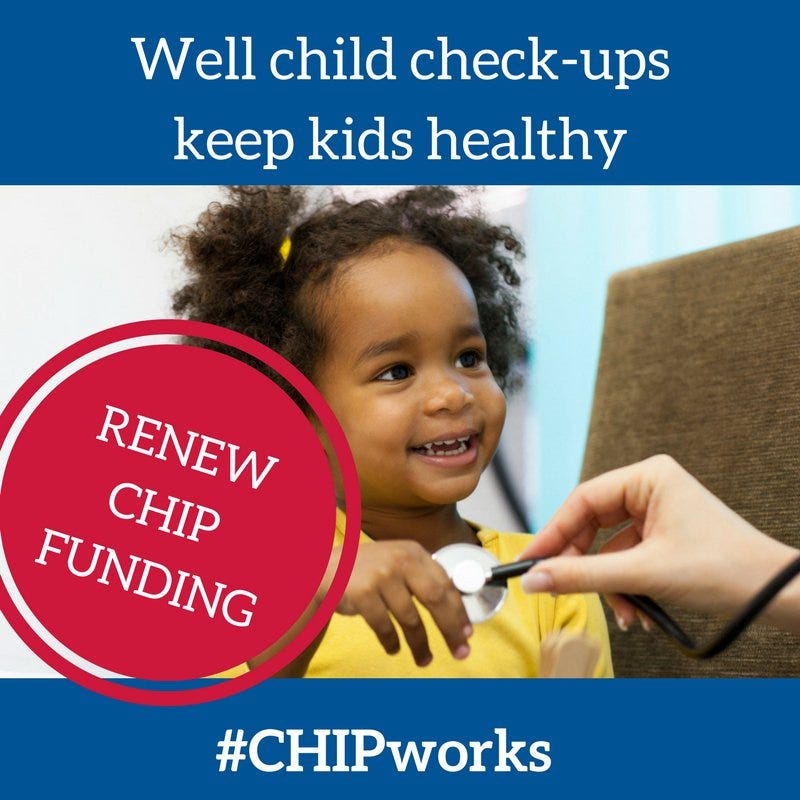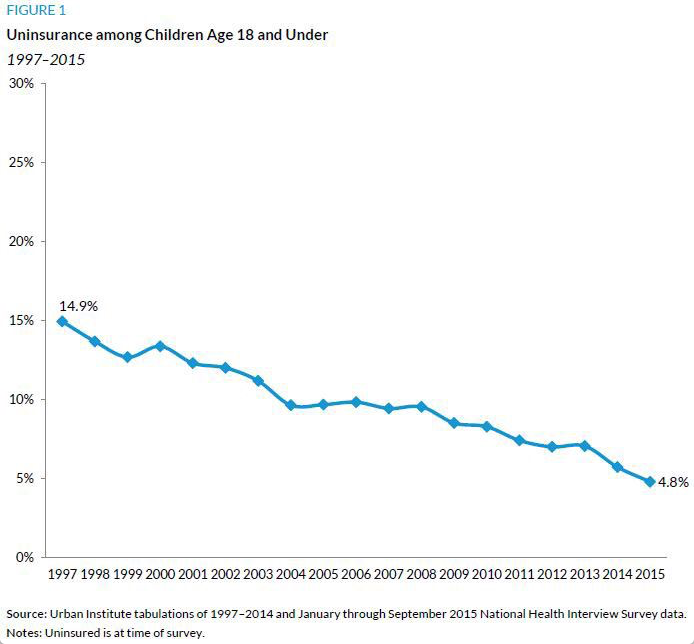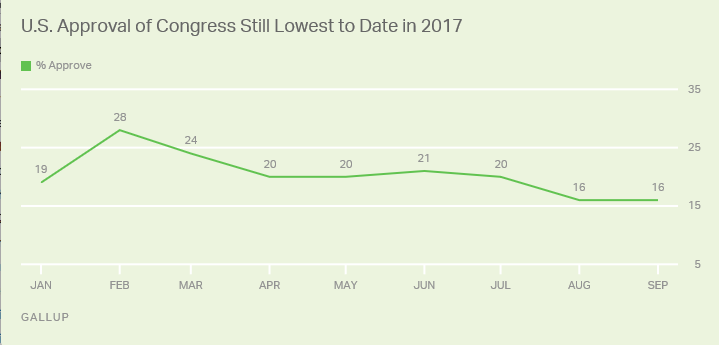EDITOR’S NOTE: This was originally published on Medium.
In the midst of the chaos that is Washington, D.C., Congress is gambling with the health and well-being of nearly 9 million children, as funding for the Children’s Health Insurance Program (CHIP) is set to expire on September 30th.
It is not like congressional leadership didn’t know this was coming. Two years ago, over 1,500 groups urged Congress to extend CHIP for through 2019, but in its infinite wisdom, House leadership chose to only extend CHIP for two years and set the date for funding to expire just days from now. In other words, this September 30th deadline was self-imposed, and yet, both the House and Senate are on a path to fail to extend CHIP funding in a timely manner. (In sharp contrast, can you imagine, a scenario where Congress would allow funding for the entire Medicare program to expire in this manner?).
Fortunately, there is some potential for action, as Senate Finance Committee Chairman Orrin Hatch (R-UT) and Ranking Member Ron Wyden (D-OR) have introduced a bipartisan agreement, S. 1827, the “Keep Kids’ Insurance Dependable and Secure Act of 2017” or the “KIDS Act of 2017.” This legislation, which would extend CHIP’s authorization and funding for five years, is strongly supported by the children’s advocacy community and the National Governors’ Association (NGA) and deserves immediate action.
First, we know that CHIP is wildly successful. At its inception in 1997, 15 percent of our nation’s children lacked health insurance coverage. To address this crisis, Republicans and Democrats, under the leadership of Sens. Hatch, Edward Kennedy (D-MA), John Chafee (R-RI), and Jay Rockefeller (D-WV), came together to forge the initial bipartisan compromise to create CHIP. Although the program began slowly, over the past 20 years, CHIP has played a critically important role in improving health care coverage for our nation’s children.

In fact, in its evaluation of the program, Mathematica Policy Research found that children in CHIP had much better access to care, fewer unmet needs, and greater financial protection than children who were uninsured.
Sen. Hatch once said that he and Sen. Kennedy believe that CHIP would “go down in history as one of the great bills.” We agree.
According to the U.S. Census Bureau, the uninsured rate for children has dropped below 5 percent. Although this remains a little known fact, CHIP, in partnership with Medicaid, has cut the uninsured rate of children by more than two-thirds in the last two decades. That is a resounding public policy success story.

This is why children’s advocates, including First Focus Campaign for Children, the American Academy of Pediatrics, the Children’s Hospital Association, the March of Dimes, the Children’s Defense Fund, Family Voices, the Children’s Dental Health Project, the Little Lobbyists, and over 1,200 other groupsstrongly support the legislation’s five-year extension of CHIP.
Second, CHIP is wildly popular with the American people. CHIP is, by definition, child-focused and families value having an insurance option for children that is specifically designed with kids in mind. Just as Medicare was designed to meet the specific needs of senior citizens, CHIP’s coverage is organized around a network of doctors, nurses, and hospitals who specialize in pediatric medicine. This ensures that children in need of eyeglasses or vaccines or who have an array of conditions, such as childhood cancer, asthma, spina bifida, or sickle cell anemia, will be treated by an appropriate health care professional.
Consequently, in a 2014 Satisfaction Survey of Iowa parents whose children were enrolled in “hawk-i“ (Iowa’s CHIP program), an overwhelming 93.7 percent expressed satisfaction with the care received and less than one percent (or 0.7 percent) expressed dissatisfaction with the care their children received. There are no insurance products that engender that high level of support — not even close.
Thus, it is not surprising that, in a survey of voters by American Viewpoint, a Republican polling firm, support for extending CHIP was 74–14 percent. Support is strong and overwhelming among every group. Even Tea Party supporters favored extending the program by a 66–18% margin.
In sharp contrast, the most recent Gallup poll finds that just 16 percent of Americans approve of the work that Congress is doing. If you were that unpopular with your boss, which for Congress is the American people, wouldn’t that inspire you to do what they want, which is to extend CHIP and not put the health coverage of 9 million children at risk?

Third, there is a great sense of urgency for anyone working closely with CHIP to get this done as soon as possible. For example, if Congress fails to extend CHIP funding prior to the end of the month, states will be forced to put in motion a variety of administrative actions, which are costly, to prepare to wind down the program, which includes sending out millions of disenrollment notices to families. According to the National Academy of State Health Policy (NASHP), which represents the CHIP directors:
. . .if Congress doesn’t extend federal funding soon, states will need to initiate contingency plans and there are costs associated with making programmatic changes. States assumed federal funding would continue for CHIP, so there are no funds allocated in state budgets to shut down their CHIP programs. As a result, states will need to use their remaining federal CHIP funds to help absorb those costs. It is hard to calculate exactly what those costs will be, but states will need to:
· Invest staff time and financial resources to develop communication plans, including notices to the public about program changes;
· Train call center staff to communicate with families;
· Review and in some cases terminate or change contracts with third party administrators or health plans;
· Make enrollment and eligibility systems changes, which are very costly;
· Develop a transition process, which may include starting with an enrollment freeze or disenrollment and transferring accounts to the Exchange;
· Submit waivers or state plan amendments to CMS; and
· Review and change state law and regulations.
States will also need to reserve a portion of their current CHIP funding to cover claims from fee-for-service medical providers as they have months (in some states up to a year) to file their claims after service is rendered. The amount of funds a state will need to withhold for future claims varies depending upon their service delivery structure, but it is a factor many states will need to consider.
These unnecessary bureaucratic expenses will take away money out of CHIP that would otherwise be used to provide health coverage to children. This is not only tragic for children, but it is also an unnecessary waste of taxpayer dollars that Congress could easily prevent to extending the program on a timely basis.
There is also immediate urgency for a number of states, which will be immediately harmed by Congress’s failure to act. One example is a provision in CHIP that corrected a problem for 11 states that were unfairly penalized with a lower federal matching rate simply because they were trendsetters and had expanded coverage to children through Medicaid prior to the enactment of CHIP in 1997. Under the “qualifying states” provision, the states of Connecticut, Hawaii, Maryland, Minnesota, New Hampshire, New Mexico, Rhode Island, Tennessee, Vermont, Washington, and Wisconsin are allowed to use CHIP funding to pay the difference between the regular Medicaid matching rate and the enhanced CHIP matching rate for those expansion kids. Those states lose that assistance on October 1st if Congress fails to pass S. 1827.
Consequently, in a letter to Minnesota’s congressional delegation, Emily Piper, Commissioner for Minnesota’s Department of Human Services, strongly urges them to extend CHIP funding prior to the end of the month and outlines a number of problems that children and pregnant women in her State will face if Congress fails to take action that include the loss of the “qualifying states” funding. She also points out that the state will have to take a number of complicated steps in order to ensure that the prenatal and postpartum care of pregnant women “continues uninterrupted” as of October 1st and that it is something the State is “exploring” but explains such a fix “comes with a significant financial penalty” to Minnesota. Again, this could be resolved if Congress would act before its self-imposed deadline.
Another example is the language related to Express Lane Eligibility (ELE) expires at the end of the month. ELE gives states the ability to streamline bureaucracy and simplify applications for eligibility determinations and renewals. As the Department of Health and Human Services (HHS) explains, “Express Lane Eligibility permits States to rely on findings, for things like income, household size, or other factors of eligibility from another program. . .to facilitate enrollment in health coverage.”
Under current law, this allows families from having to prove to states — often the same state agency — what their income, residence, and family size are again and again and again in order to qualify for services. However, if this provision expires, the states of Alabama, Colorado, Iowa, Louisiana, Maryland, Massachusetts, New Jersey, Oregon, Pennsylvania, South Carolina, South Dakota, and Utah may have to seek waivers or otherwise be required to change their eligibility systems and reestablish certain bureaucratic functions at administrative considerable costs that burden families and decrease health coverage for children.
Unfortunately, some members of Congress fail to understand that there is any sense of urgency because that projections of when CHIP dollars are exhausted may not be for several months from now. However, these projections are nothing more than estimates. As NASHP explains:
Most importantly, the projections [of carry-over funding] are made using data from previous months’ expenditures, which is the best information states have. But they are just projections. There are factors that could result in states spending more for their CHIP programs in the coming months that are not captured in the current projections.
For example, the states of Texas, Louisiana, Florida, and Georgia have all been greatly impacted by Hurricanes Harvey and Irma in the last few weeks. Therefore, it is highly likely that any previous projection of when their state CHIP dollars would run out are undoubtedly way off now.
While Congress continues to explore ways that they may either modify or repeal the Affordable Care Act (ACA) or Obamacare, if CHIP funding is not extended, the states will have no choice but to explore ways to begin trying to move children into Obamacare, which is both costly and rather ironic, since a Republican-led Congress would cause that to happen. As NASHP points out:
During a recent conference call with representatives from state CHIP and Medicaid programs, several officials expressed serious concerns that CHIP funding had not yet been extended. Given the ongoing uncertainty, they are beginning to coordinate with health insurance Exchange officials to develop transition plans. They are seriously considering the policy and systems changes required to seamlessly transition children currently covered by CHIP that may be eligible for the ACA tax credits into qualified health plans (QHPs).
The systems are currently designed to ensure that children eligible for CHIP are enrolled in that program and not in a QHP. If CHIP ends and children need to be transitioned to other potential sources of coverage, there are layers of decision points embedded in state and federal eligibility systems that support enrollment in CHIP that would need to be redirected to ensure a child does not get stuck pinging between the Exchange and a CHIP program that is in in the process of being shut down. Identifying and implementing the necessary changes and testing the updated systems will require time and substantial funding that states, which are expected to exhaust their CHIP funding by early 2018, do not have.
These things should never happen and Congress could easily alleviate such problems. Doing so would be logical, prudent, popular, and really, a no-brainer.

Investing in our children’s health is investing in America’s future. When we help our children develop and thrive, we are paving the way for our country’s next generation of workers and leaders to succeed. It’s well past time that we made kids a national priority the same way parents make them a family priority. Children should no longer be treated as an afterthought by our congressional representatives.
Former Senate Majority Leader Bill Frist (R-TN) recently called upon the Congress to extend CHIP. As he wrote in Forbes:
CHIP is what a successful, effective government program looks like. Historically, Democrats and Republicans have not hesitated to preserve and strengthen it. They should do so again now.
Frist adds:
I do not ask Congress to reauthorize this program for the sake of protecting a political legacy, mine or otherwise. Nor do I call on them to do so for the sake of bipartisanship, though our country would certainly benefit from it.
Instead, I urge them to reauthorize this program for the sake of the next generation — a generation that can make our economy stronger, keep our country safer, and forge an even greater, broader, more robust version of the American Dream.
For, if we insure our children, we ensure our future.
We strongly agree and ask for your help by calling your two senators and congressional representative to urge them to support S. 1827, the “KIDS Act of 2017” and push for its immediate passage. The health and well-being of nearly 9 million children are at stake.

